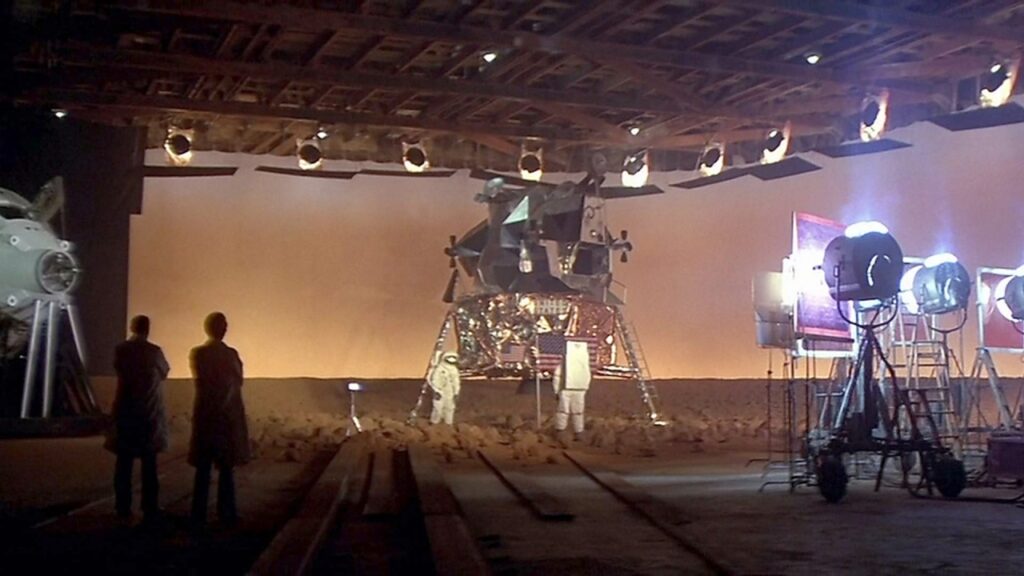Written and directed by Peter Hyams
I’m going to pick 13 movies. They may be an influence on my writing, on my filmmaking, or on my thinking. They may just be movies I like. There may be more than 13.
The black helicopters swoop down on the biplane like angry locusts. They communicate by turning to face one another, as if sentient. This theatrical flourish made such an impression on me as a boy, watching Capricorn One on afternoon TV, commericals and all. The impression was so strong, I started to ferment the ill-conceived notion to make movies.
Other flourishes that elevate Capricorn One above your standard afternoon matinee: the loooong fade in on the Saturn V rocket that will carry three astronauts to Mars. The lengthy monologue brilliantly delivered by Hal Holbrook. The stagey word volleyball played between Elliot Gould’s reporter and Brenda Vaccaro’s grieving widow. And the story. Always the story.
Capricorn One resides firmly in 1977, in a long line of conspiracy thrillers that includes The Parallax View, Three Days of the Condor, and All The President’s Men. Peter Hyams’ entry had the good fortune to ride the Star Wars space zeitgeist, but it’s more earthbound, with an evil corporation and corrupt bureaucrats as the villains rather than a towering man in a mask.
I love Jerry Goldsmith’s bombastic music. I love the step process ending. I even like O. J. Simpson’s horrendous acting. There is the way people just disappear. Who is the woman living in Caulfield’s friend’s apartment, and how can such an unassuming person be in on the conspiracy? Why does Sam Waterston’s astronaut spend so much time climbing a butte and why does he expend effort telling a joke while doing it? Why, so his climb can end in an astounding aerial shot featuring—the black helicopters.
The black helicopters also feature in the amazing final chase scene. Ignore the dated rear-projection inserts of the actors and enjoy this thrilling CGI-free Hall of Fame sequence, where the helicopters actually bump Telly Savalas’ biplane with their skids, all while James Brolin’s stunt double grips the wing struts perilously. (This cast is straight out of 1970s Hollywood, with David Doyle and Karen Black rounding out the credits.) If you watched action shows in the 1980s, chances are you saw the recycled crash footage from Capricorn One. The slow tumbling of shredding metal is a wonder of theatrical pacing.
Peter Hyams would go on to direct a number of movies I enjoyed, including 2010: The Year We Make Contact, Running Scared, and Outland. His B movies (such as the Jean-Claude Van Damme starrers Timecop and Sudden Death) shine in their craft, even with weaker stories. Even his C movies (The Musketeer, A Sound of Thunder) refuse to surrender a modicum of quality. A fellow Syracuse grad and Broadway scion, Hyams doesn’t shy from long stretches of theatrical dialog. As a fan of Preston Sturges and David Mamet, I often attempt the same artistic conceit (to lesser effect). His cross-cutting between Holbrook’s “eulogy” and the escape (featuring another astounding practical shot, when the jet’s landing gear smashes into a windshield) is both obvious and extremely effective. Hyams always swings for the fences, never just working for the paycheck. He is a consummate craftsman—a writer, director, producer, and director of photography. Most agree Capricorn One is Hyams’ magnum opus, insofar as he has one. It’s wildly entertaining, energetically creative, and propelled this boy into a lifetime of filmmaking buffoonery and chasing the stars. Which is more than the three astronauts got.

